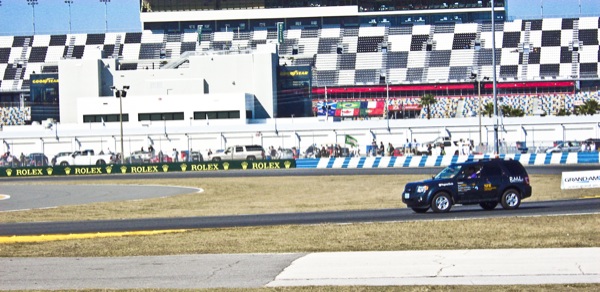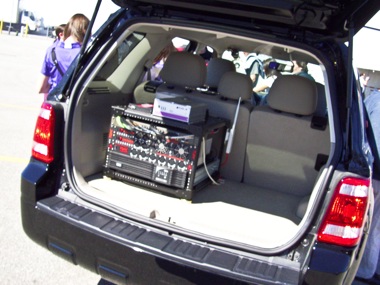Have you ever driven in a car when someone suddenly cuts in front of you, and then you or another passenger shouts out to the errant driver, “What’s the matter? Are you blind?”
Well, you may want to think again before saying that in the future. It is doubtful that a good blind driver would cut in front of you like that, but there could be a blind driver driving a car.
Impossible?
Well, on January 29, a historic event took place on the famous International Speedway of Dayton Florida just prior to the “Rolex 24” Racecar Event. As part of “The Blind Driver Challenge,” United States Congressman John Mica handed the keys to a blind person to drive a Ford Escape Hybrid (SUV) auto. The blind driver put aside his cane, entered alone, and started the car. He successfully drove it from the Start Line through a pre-set obstacle course, and then onto the famous “Chicane” hairpin turns of the Raceway, right in front of our grandstand seats. Finally, he dodged boxes that were thrown on the roadway from a van driving in front of him and later safely passed that van. Success!

NFB Blind Driver Mark Riccobono (in car, not pictured) brings car onto the turns of the Racetrack. (Photo provided)
Hundreds of people around us burst into applause and cheers and tears as another “impossible” barrier to the blind came tumbling down. Someday, blind drivers will be able to drive to better jobs and drive their families to shopping and grocery stores, freedoms the rest of us take for granted.

Mary Kozy holds one of the high-tech gloves of the Blind Driver. (Photo provided)
My wife Mary, who is blind, was at my side along with her Guide Dog as we witnessed this historic event. We were overjoyed. Tears came to my eyes as I realized the courage, faith, and hard work that went into this achievement. Awesome is too small of a word to describe the “impossible,” which just occurred.
Next, we all proceeded to the Raceway infield to celebrate our joy with food and fun, to view the auto up close, and to speak with its driver and engineers!
Yes, a blind driver had been in complete control; the car was not controlled by a computer or device. That car had the same steering wheel, brake pedal, accelerator pedal, gear shift, and new-car scent as the one you and I can buy at our local Ford dealer. The blind driver, Mark Riccobono, controlled the movement of the auto with the same motions that we sighted drivers use.
Impossible? How could this be? Well, here is a brief, simplified explanation.

Computer “advisor” behind rear seats of Blind Driver’s car. (Photo provided)
Mark wore a pair of open-fingered gloves that had vibrators attached at each of the fingers, which “advised” when to turn and how much to turn. For example, a vibration on the right-hand pinky meant turn a little right, while a vibration on the left index finger meant turn a sharp left. The added seat cushion Mark sat on gave him “advice” on how fast to go and when to apply the brakes. For example, a vibration on part of his leg meant medium braking, while a vibration on the driver’s back meant it is OK to speed up a little. Mary and I got to touch the gloves, the vibrating seat cushion, and the car after the demo drive.
Where did this vibration “advice” for turning and speed come from? Behind the back seats of the Ford Escape sat a computer, a cube about 18 inches on each side, which electronically sent “advice” to the vibrators in the driver’s seat. The key idea was that only “advice” was given and not any control of the car’s functions, because control of the car was the driver’s responsibility. The computer gave its best “advice” based upon information from special sensors installed around the bumpers and doors of the auto that sent out and interpreted laser and radar-type signals to determine important information such as the surroundings, obstacles, speed, and direction. (Even my Ford Fusion Hybrid today has some motion detectors and alarms that “advise” me of people or cars passing as I back out of parking spaces.)
So the computer sent its “advice” to the driver’s hands, feet, and back via those vibrators. The blind driver did what all other drivers do: turn, accelerate, and brake, and enjoy driving.
The Bible says: “The blind shall see.” Thank God, now the blind also can drive. Days before, when Mark drove his wife and two children, he said, “It was more difficult to buckle up the child seats than drive the car.”
Why is this event so important for us sighted drivers? Well, after we have our midlife crises, it suddenly dawns on us that we are not invincible and that our body parts, including our eyes, start to deteriorate with age. Maybe eye glasses correct our vision at first, but we know many people with macular degeneration, glaucoma, and diabetes that attacks their vision. Finally someone, usually our son, daughter, or doctor asks us for the keys to our car. When that occurs, we can no longer drive and have lost some independence. That day will be very unhappy for us.
But now, there is hope! Hope not only for those who are blind or have low vision but those of you who will be losing your vision, as gradual a loss as it may be now. Given good health otherwise, you will be able to drive because of this type of technology.
“The Blind Driver Challenge” has been successfully achieved through the efforts of the National Federation of the Blind and the Virginia Tech University’s RoMeLa laboratory (where Students programmed the computer and used off-the-shelf TORC and DARPA technology). This technology and application are still in research and development. The auto was privately purchased.
Now it is up to all of us to help and encourage those working on this important research, to propose a new “Older Low-Vision Driver Challenge” that could be of vital importance to each of us in the future.
Or, is this “impossible?”
For news articles, audio, and video and how to help, go to: www.BlindDriverChallenge.org.




